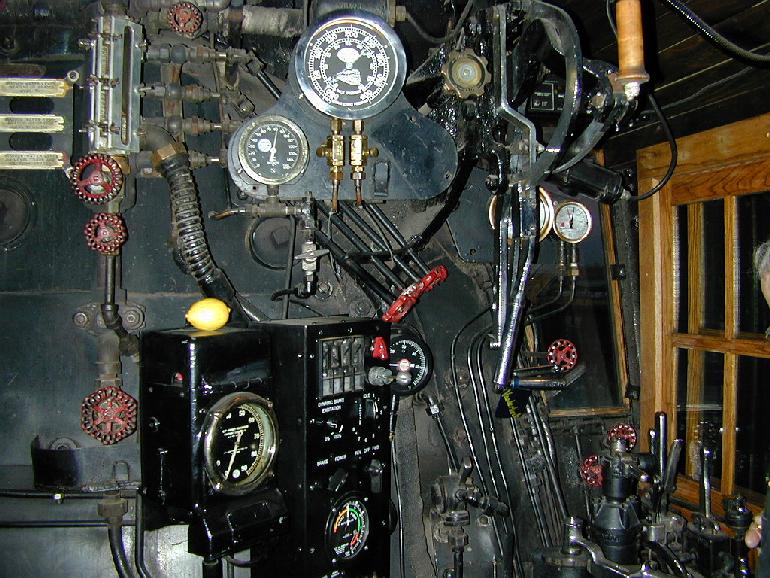
The Cab In the cab you are struck by its physical impossibility, it is larger on the inside than on the outside. There are a great number of control levers, gauges, and valves.The throttle handle is about two feet long. It is nickel plated. It is pivoted high up near ceiling of the cab near the top of the boiler backhead making it offset from the engineer to his left and front. About 1/3 down the length of the handle is a chrome-plated quadrant. The throttle quadrant resembles a gear. The outside (bottomside) of this quadrant has many teeth on it which the throttle latching mechanism engages to hold the throttle where the engineer puts it. To operate the throttle from the closed position to the fully open position requires moving the throttle handle through an arc of perhaps 60 degrees and a distance of at least two feet. I used to think the handles of the 16 notch GE U25C's were long but the 4-8-4 certainly has those beat. I did not count them but the 700's throttle quadrant has far more than 16 "notches" on its quadrant. Probably three or four times as many. But those "notches" are not used in the same manner as a diesel's throttle notches are used.
Just to the left of and a little farther back from the throttle is a second somewhat similar looking handle. This is the Drifting Throttle. It is used when the locomotive is drifting with the main throttle closed such as going down grade for long distances. The locomotive normally runs on "Dry Steam". This is steam that has been superheated well above the condensation point. In the case of the SP&S 700 about 300 degrees higher. Dry steam is much more efficient than saturated steam but is harder on lubrication. When going down long grades the drifting throttle puts saturated steam into the cylinders to aid in lubrication.
Another important steam engine control is the valve that controls the opening and closing of the cylinder cocks. It is located near the boiler backhead just to the left and in front of the engineer. Steam may condense in the cylinders while you are stopped. If you don't blow it out before moving the locomotive the water will cause a hydraulic lock in the cylinders and possibly force off a cylinder head or cause other major damage. So before moving a steam loco the engineer always opens the cylinder cocks to give the condensate an escape route other than a pried off cylinder head. This is much the same thing as opening cylinder cocks on a diesel engine and barring it over to expel water before starting the engine. But on a steam engine you need to do it every time you move the locomotive so there is a "remote control" for the cylinder cocks.
On older or smaller locomotives the reverser is a long handle called a Johnson Bar. By pulling or pushing on the Johnson Bar the engineer operates linkages connected to the valve gear to place the locomotive in forward or reverse and to adjust the valve timing called "cut off". The valve gear on an engine the size of the SP&S 700 would be very difficult to operate manually so the 700 has a power reverse gear. Air pressure operates a piston in the power reverse cylinder and moves the valve gear into the desired position. Steam can be used to operate the power reverse in emergencies should air pressure to it fail. Because the 700 has power reverse, instead of a long handled Johnson Bar it has a much smaller reverser handle. The reverser is located near the right hand cab wall.
The 700 has the 8ET type of automatic (train) air brake valve. It and the independent brake valve are located immediately in front of the engineer. The familiar two duplex air brake gauges are located near the top left of the front cab window.
The sander valve and bell ringer are both located along the right side cab wall in front of the engineer. The headlight dimmer switch is an ancient knife switch affair just like the one I had on my first locomotive in 1968. That one was on a New York Central EMD 600 Hp SW-1 switcher. It should not have been a surprise to see the 700 had the same type of headlight switch since the SW-1 was built in 1939 and the 4-8-4 was built in 1938.
Other devices include boiler blow down, injector control, water level site glasses, water level try cocks, and a whole slew of valves for turning on and off such things as the air pumps, injector, turbo generator, steam train heat, and lube heat.
The 700 has quite a number of gauges on her. All of them are encased in fancy brass cases with glass faces and most are quite large compared to modern gauges. The needles and numbers have an antique grandfather clock look. Pretty classy. The main gauge of course is the boiler pressure. A large duplex gauge shows steam chest pressure and cylinder, or exhaust, backpressure.
On the fireman's side are the main firing lever and the injector lever along with various valves and gauges.
The 700 has a "blackbox" with an ammeter and the necessary switches for operating a conventional diesel locomotive MU'd behind it. The diesel is sometimes used as a helper on the steepest hills and for dynamic braking on long down grades. But its main reason for being there is because the host railroads want it there. It is "insurance" to clear the mainline and to deliver the passengers should anything disable the steam loco.

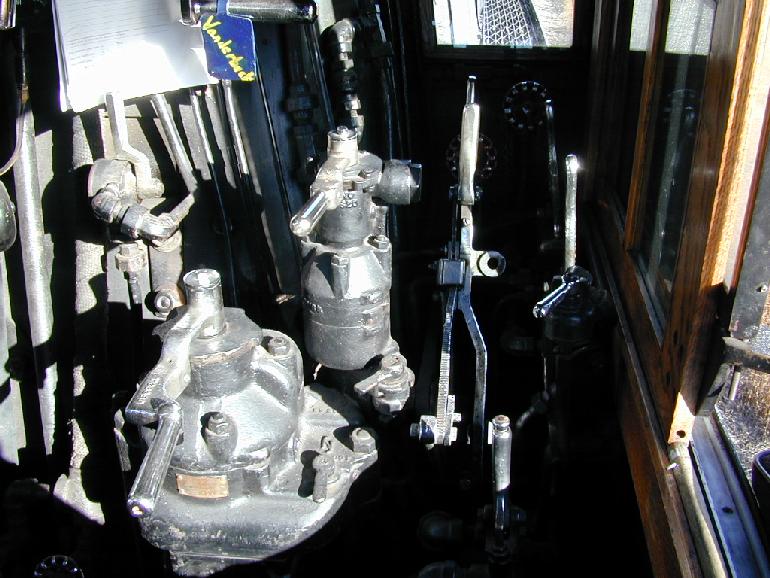
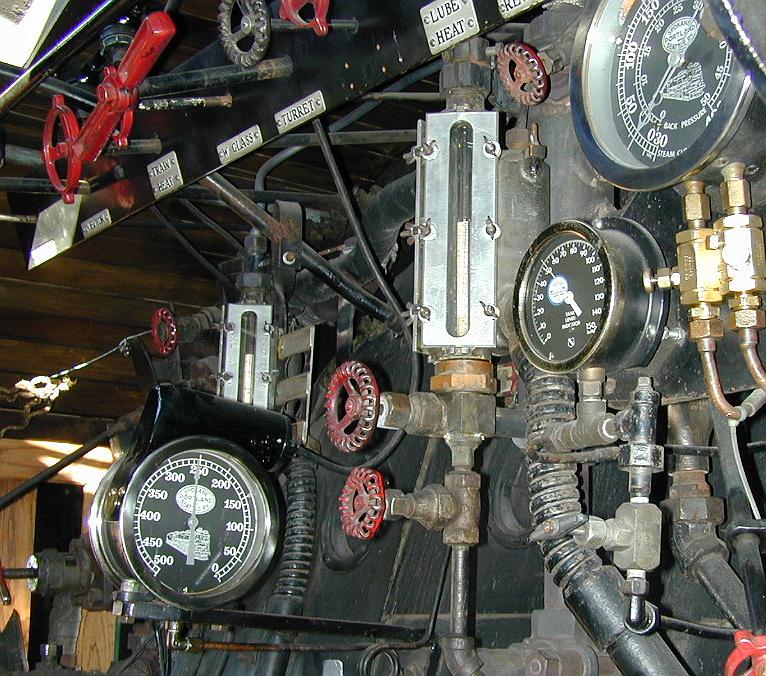
The locomotive was kept hot during the three days it sat at Billings. This is done to lessen the thermal expansion/contraction wear that occurs if the beast is otherwise subjected to the wide temperature range. The air temperature that afternoon was in the mid fifties and I was wearing a light nylon jacket. After I was in the cab a while I was getting quite warm. Without a jacket it was very comfortable in the cab even though the back of the cab is open and the windows were open. The radiation from the boiler backhead is quite sufficient. I can't help but wonder what it would be like on a steam loco crossing the New Mexico, Arizona, and California deserts when the ambient temperature is 120 degrees! Those old crews must have been a lot tougher than I am.Shortly after I got aboard I sat down in the fireman's seat and snapped this photo through the fireman's front window. The locomotive is parked behind the train in these picures. You can see that visibility from a steam locomotive is extremely limited.
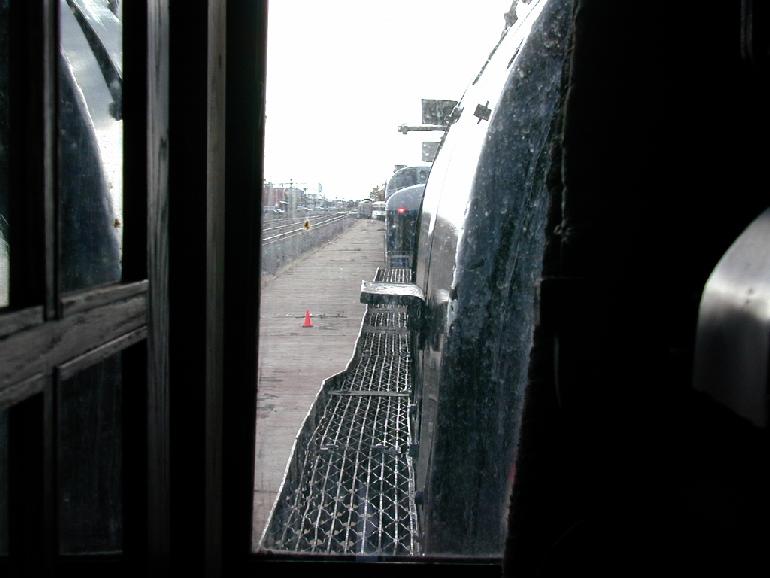
The next photo was taken while hanging out of the fireman's side window.
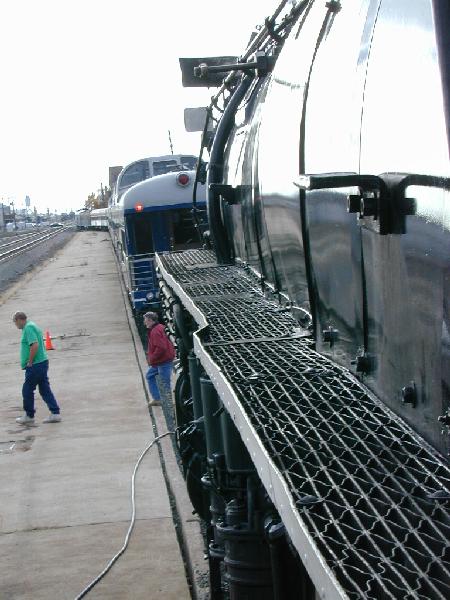
People were coming and going in the cab. Some asking questions about the locomotive. The engineer was a very polite man and of course knew all about the 700. He is certainly a great attribute to the preservation group public relations-wise. At one point the cab cleared out and I began conversing with the 700's engineer. I was asking questions about the operation of the Northern.It became apparent to the 700's engineer that I was an engineer myself and that I worked out of Sheridan, Wyoming. He asked me if I knew an engineer named Al Krug? Yes I said that I did. He said that he knew "him" from the Internet. We had emailed each other a few times and we have read each others' many posts to the railroad boards. The engineer said that he enjoyed Al Krug's "Tales" series of life on the railroad. He said that he had never really met Al Krug personally. I said, "Yes you have" and finally introduced myself.
The engineer was Jim Abney. I had known him only by his internet I.D. Jim's regular job is as an Amtrak engineer in Oregon. We talked in the cab for the better part of an hour. We talked about the 700 and about our own individual railroad experiences. Basically swapping railroad tales. My conductor who had been standing outside decided I had been taken hostage and climbed into the cab to find me. While Jim and I continued talking between his attending to the public visitors, my conductor sat in the fireman's seat. I regret not having taken his picture there during one of the rare periods when no one else was in the cab.
The Invitation There are two engineers that traveled with the 700 on this trip. Greg Kamholz is the other. They run on alternate days. Greg was going to run on Friday from Billings to Bozeman. Jim was going to run on Saturday from Bozeman to Missoula. Toward the end of our conversation Jim did something remarkable. He asked me if I would like to come to Bozeman, Montana on Saturday and ride with him in the SP&S 700! I said I would like that very much but the logistics of it might be difficult. This was Wednesday. He understands all too well the difficulty of an engineer laying off for three days over a weekend on short notice. I also was wary of my bad luck in trying to see operating steam locos. Almost as if he had read my thoughts, just before I left the cab he remembered as an after thought that there were going to be some MRL officials in the cab on Saturday. That sort of sounded like the invitation was off.My conductor and I left the locomotive to go get our new safety boots. I remarked to him that it sure would have been fun to ride on the 700. I would really like to see how it rides and, although I had a pretty good idea of it, I also would like to see just exactly how it is operated. I know the theory of it but what is the reality? How DOES the backpressure behave before during and after "hooking her up"?
We got our boots and drove back to Laurel. In my room I began thinking about a ride on the 700. The logistics just were not there. Because laying off can be hard to get approved I have 30 personal leave days saved up from previous years. Four weeks earlier I had put in a Personal Leave Day (PLD, paid) lay-off request for Sunday the 20th of October. I had also put in a Lay Off Personal (LOP, no pay) for Monday and Tuesday. You have to put in for lay-offs separate if you don't want all of the days PLD or all of the days LOP. The stupid computer will not allow you to mix the type of lay-off. My wife had an eye doctor appointment in Billings early Monday morning and I was to drive up with her late on Sunday since she can't see afterwards. In my lay-off requests I stated the reason and that I needed BOTH requests approved or neither request. The ignorant crew managers declined the Sunday PLD but approved the Monday-Tuesday LOP. I was angry and figured on just laying off Sickness In Family (SIF) when Sunday the 20th got there anyway. I get tired of trying to do it their way and still getting shot down.
So that was the situation as I sat in my crew room at Laurel. If I laid off Friday and Saturday to go ride the 700 then I would have to also be off Sunday-Tuesday for Linda's doctor appointment. Five days. In addition this was the first week of Elk Season. I am not a hunter but in Wyoming the start of Elk Season is a VERY big deal. The schools are short of pupils and the railroad is always out of crews. To get off I would most definitely have to lay off sick (LOS). Being Elk Season and the fact that I had already put in a request to be off which was denied, laying off sick is apt to be scrutinized closely. My bad luck with steam is continuing.
I called my wife and told her about finally getting to see the steam loco and mentioned the possibility of a cab ride on Saturday. She said that she had Call-Back on her job at the hospital this weekend. She would have to stay in town. I needed her to chase the train if I got on it and to pick me up wherever I got off. She said that she might be able to get one of her co-workers to swap weekends with her if I wanted it. I hmmm-hawed around a bit then said to forget it because of the difficulties I'd have laying off the whole five days. She of course was aware of our past failures of steam loco observations. I told her about Jim's after thought of the MRL officers riding Saturday and that I was not absolutely certain I still had an invitation. She said I should get it straightened out one way or the other and if possible go for it.
I sat in my room pondering upon the possibility for a while. Finally about 8:30pm I decided I have to know one way or the other. If this is for real then I am going to make one more attempt to see live steam in action. I got in my away-from-home truck and drove back over to Billings and the SP&S 700. I arrived just before 9pm and was surprised and relieved to see that Jim was still in the cab. There were a couple of old time retired railroaders in the cab talking with him. I climbed on board the 700 for the second time that day. When the oldtimers left I asked Jim if the offer to ride was still good. Yes it was. What about the MRL officers in the cab Saturday? "Always room for one more" was his reply.
The cab was illuminated only by the cab lights. I stood there and we swapped a few more rail tales. Somehow the tales seem better with the muffled hiss of steam in the background and the boiler's radiant warmth on a crispy October Montana night. About 9:30 PM I thanked him and told him I was going to try to get to Bozeman on Saturday. I needed to get back to Laurel and get some sleep before getting called out at 4am. I gave him my home phone number asking him to call if he should break a leg before I left for Bozeman Friday. My bad luck with steam just did not permit me to be really excited about this. Something was going to go wrong.
Back at Laurel I again called my wife. Ignoring my instructions, as usual, she had gone ahead and gotten a co-worker to cover for her that weekend. Bless her.
But I started thinking of other logistical problems. Linda is not a railfan. She knows little about railroads other than my frequent complaints. The MRL splits 30 miles west of Bozeman. The interstate follows the wrong route. Until I tell her of that she will not know and would be following the wrong track. OK I can explain that one. But what other troubles can she get into. Could she find me where I get off the train? I knew that a large part of the MRL railroad between Bozeman and Helena was not readily accessible. If we should break down and I needed to get off in the canyon could she find me? If we had to back out of the canyon how would she know?
I was not even sure how far I'd be riding, if at all. Jim had invited me to come to Bozeman and ride. I realized that no mention had been made of how far? I had asked him where the first water stop would be and he replied they would look at it when they got to Helena. So I figured Helena would most likely be the first stop.
Linda and I have been through Helena, Montana many times. I know the railroad either side of Helena as it is alongside the highway or I've followed it on the Forest Service roads. But I had never been to the yards in Helena. I did not know if there was even a passenger depot left. If I got off at some back corner of the yard at a yard shack deep in an industrial area could Linda find me? We needed some way to communicate. We do not own a cell phone. With our exclusive 8-hour call I do not need one. I resolved to go to Wal-Mart when I got home on Thursday and buy a couple of those TracPhones, an apropos name in this case.
For over a year there has been a Sperry rail detector car parked on the house track at the Laurel depot next to the crew complex. It is one of those yellow "doodlebugs". Number 129 I think? But that night there were two of them parked there. I wanted a photo but it was too dark and a truck was parked in the way. I figured maybe I could get a single photo with both cars in it in the morning.
I went to sleep and did not get called for 4am. Instead I woke up the next morning just before the phone rang. The caller said I was on duty for 0945 for the expected SPB coal empty. I went to check on the Sperry railcars. The second one was gone.
We departed Laurel Yard at 1135. Passing the west end of Billings yard we met the missing Sperry car. It was inspecting the westbound main for rail defects.
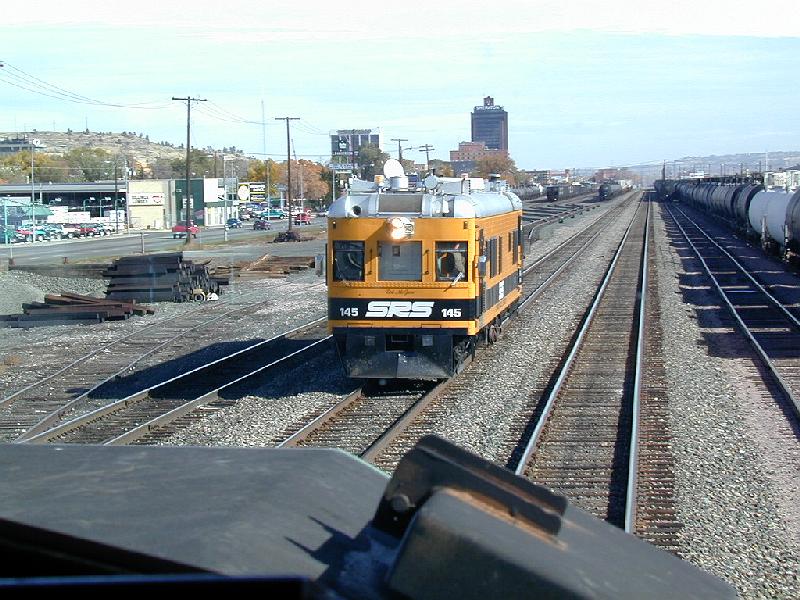
It was almost noon when we finally passed the SP&S 700 at Billings. I took this shot of the train from the cab of the BN 9217, an SD60M.

Here Kirk Petty, a Sheridan engineer, is standing in front of the 700 talking to the security guard. The security guard (and 700 water procurer) is Joel King. Joel works with Bob Bateman on the Alder Gulch Shortline steam engine at Virginia City, MT. (I'll get to Bob later on). These photos also illustrate the nasty reflection problem of those GP60Ms with the three piece windshields.
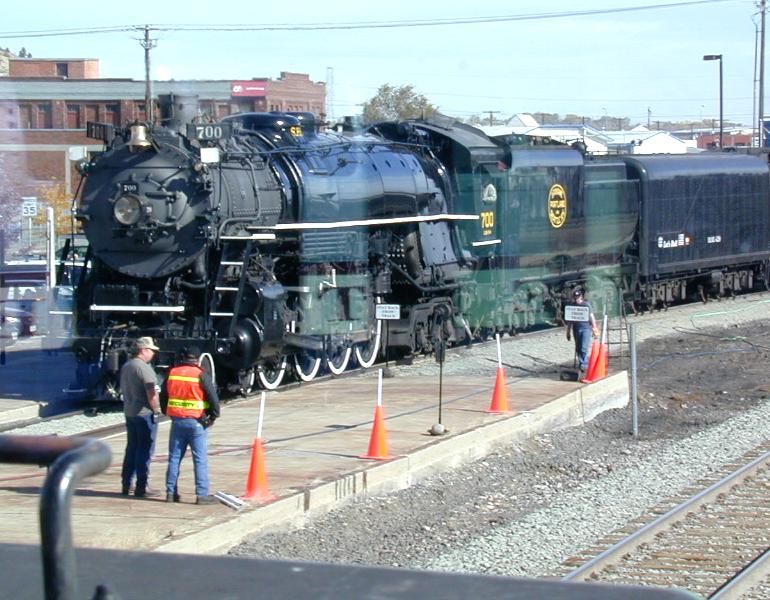
The Ride is Off? The trip home on the empties was not a particularly good one and I did not get tied up at Sheridan until 1845. My wife met me at the door. "I got a phone call from Jim Abney...."I knew it. I just knew it. The trip is off just like all the rest of them. She continued, "He said that he had found out that a video crew would be riding the 700's cab on Saturday. He could not guarantee that I could ride her". I would have bet money that something like this would have happened. My luck seeing steam in action is the worst in the world. Well at least I found out about it before buying a couple of cell phones and driving a 600 miles roundtrip. Linda said that Jim told her I was still welcome to come ride and that I could ride the tool car if not the cab.
What leads up to a situation does affect your perspective on it. Any other time the chance to ride the nearby tool car behind a big steam loco would have been thrilling. But I had just been bumped from the cab! I told Linda we may as well forget it. The trip is already falling apart so I may as well work my job Friday and Saturday then go with her to Billings as originally planned.
She didn't see it that way. She had re-arranged her schedule and had even gotten a co-worker to swap a half day Friday so she could get home at noon. The drive to Bozeman is a good four hours at 75 mph in the daytime with dry roads. If we could leave just after noon instead of after 5pm the drive would be safer and faster. Besides she said, "You know you'll enjoy watching it from the tool car".
Yes I would. As far as pictures were concerned I'd probably get better ones from the tool car than the cab. But I had so wanted to see how it rode and how it was operated. OK we'll go.
Getting There By now I figured this was a once in a lifetime opportunity and I was not going to miss it if I could help it. I had a bad ache in my body and it could only be cured by a liberal application of steam. The next morning I called up and laid off sick to obtain the cure.
(Note: For you purists, I really did have a splitting headache at that time so I would not have worked that roundtrip anyway.)I borrowed a cell phone from a retired engineer friend and bought a TracPhone at Wal-Mart. I spent about an hour and a half on the internet setting up the TracPhone then testing it. I packed a small bag and was ready when Linda came home after noon.
The weather was delightful. It was sunset by the time we arrived at Bozeman Hill west of Livingston. An eastbound freight was about to enter the west portal of the tunnel as we cruised past on I-90. It looked like our H-PASKCK. The MRL SD45 helpers were shoving hard on its rear end. Some of the SD45s were smoking badly. The air was filled with smoke backlit by the setting sun as we entered Bear Canyon. Part way down the hill we met another eastbound. This time a BNSF grain empty. The haze was so thick in the canyon that we had to slow down because we could not see where we were going. I wondered if the 700 had done that? Was its smoke pall still hanging in the canyon? I would not think it would smoke that much going downhill. I looked behind us at the sunlit hills. They seemed clear of smoke. Apparently the forward view was just the effect of the smoky SD45s' trail being backlit by the brilliant sun.
It was pretty much dark as we pulled into Bozeman. From I-90 we could see the 700 and its train parked at the depot. Not wanting to waste time in the early morning trying to find my way to the depot we scouted out the most direct route. I parked the Explorer next to the souvenir trailer and walked over to the 700. I asked a man wearing an orange vest if he had seen Jim Abney around. No he hadn't. It wasn't his day to run he informed me though I already knew that of course. He asked me who he should tell Jim was looking for him should he see him at the motel? I told him to just say that Al Krug was here and I'd meet him in the morning.
Since Linda had not seen the 700 yet we walked by the locomotive. She wanted to know what all the "gizmos" were so I explained. We walked back to our vehicle in the semi-darkness. As I was unlocking the door a man from the souvenir trailer asked if I would like to buy a hat, a shirt, or perhaps a book? I was eager to get to our motel and replied, "Maybe tomorrow".
He said, "What is Jim going to think when you show up tomorrow without a hat?"
It was then that I recognized him as the gentleman I had spoken to a few minutes earlier. Well I was planning on buying a hat and I couldn't resist the fellow so I said, "OK you got me". He put his hands in the air and said, "Hey, no high pressure sales tactics here". We both had a chuckle out of it. (OK so you had to be there). I bought an SP&S 700 hat. That man was Arnie Holden, definitely an asset to the 700 group.
| Return to Tales index | My Home Page | E-Mail me |
Created 10-25-2002
Updated 11-20-2002